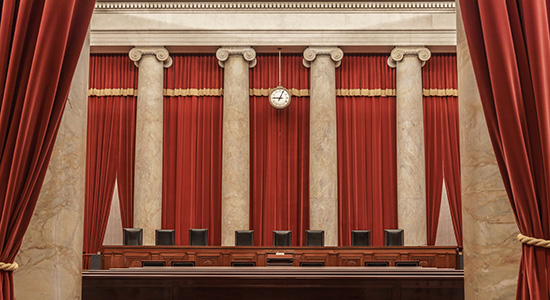
Aug. 1, 2018 – The U.S. Supreme Court’s term ended in dramatic fashion in June, capped by Justice Anthony Kennedy’s retirement announcement and the recent nomination of Brett Kavanugh by President Donald Trump to take Kennedy’s place.
Commentators speculate that a Judge Kavanaugh confirmation would move the court decidedly “right” on hot button issues, based on his prior rulings for the U.S. Court of Appeals for the District of Columbia as well as work for Republican causes.
“Judge Kavanaugh’s long history of legal opinions, as well as his role in some of the fiercest partisan battles of the last two decades, will give Democrats plenty of ammunition for tough questions,” political writers for The New York Times noted.
As the confirmation battle mounts, other commentators – including the lawyers and law professors who provide comprehensive insights for SCOTUSblog – have thoroughly dissected the major decisions of the 2017-18 term, including two Wisconsin cases.
The nation’s High Court heard 63 cases, and decided 59 with signed opinions. Two cases were dismissed, one was affirmed by 4-4 vote, and one was decided with a per curiam opinion. SCOTUSblog noted that this term saw an “uncommonly low level of unanimity,” with only 39 percent of cases (20 cases) decided by a 9-0 decision.
Nineteen cases were 5-4 decisions. Although Justice Kennedy was known as a swing justice – a crucial vote in split decisions – that was not the case this term.
Kennedy, appointed by Ronald Reagan in 1988, sided with the so-called “conservative” justices – Chief Justice John Roberts, Justice Clarence Thomas, Justice Samuel Alito, and Justice Neil Gorsuch, all appointed by a Republican President – in 14 cases.
In fact, Chief Justice Roberts was more of a swing voter than Kennedy this term, siding with so-called “liberal” justices – those appointed by Democratic Presidents – in three cases, including a Fourth Amendment search and seizure case in which the 5-4 majority concluded that police needed a warrant to access cell phone location data.
“[U]ntil now, the prevailing legal theory was that if an individual voluntarily shares his information with a third party – for instance, by signing up for cellphone service – police can get that information without a search warrant,” wrote Nina Totenberg for NPR.
Wisconsin Cases
One of the most highly anticipated cases of the U.S. Supreme Court’s term originated in Wisconsin and involved the voter redistricting maps that Republican lawmakers drew in 2011. Litigation ensued immediately and may still be ongoing, after the Court’s decision.
 Joe Forward, Saint Louis Univ. School of Law 2010, is a legal writer for the State Bar of Wisconsin, Madison. He can be reached by email or by phone at (608) 250-6161.
Joe Forward, Saint Louis Univ. School of Law 2010, is a legal writer for the State Bar of Wisconsin, Madison. He can be reached by email or by phone at (608) 250-6161.
Legal commentators speculated the Court’s decision in Gill v. Whitford could be a landmark one for political gerrymandering, one way or the other. A three-judge panel had ruled (2-1) that Republicans engaged in unconstitutional gerrymandering in drawing the statewide maps, which divide the state into Senate and Assembly districts for voting.
The state constitution requires the Wisconsin Legislature to draw new voter districts every 10 years after the federal census, to account for population shifts.
But the U.S. Supreme Court unanimously (9-0) ruled that plaintiffs lack standing to assert unconstitutional gerrymandering claims for a statewide map unless they actually live in a district that was “packed” or “cracked” by unconstitutional gerrymandering.
“Even though Gill did not shatter barriers on substantive partisan-gerrymandering doctrine, that this often-split court chose to speak with one voice on partisan gerrymandering (no less) makes the case an outlier — an outlier that marks out some of the trail for the next litigants in line,” wrote Theresa Lee and Emily Zhang.
“Gill v. Whitford began as a blockbuster election-law case and ended (this time) as a federal-courts decision with a hint of trial strategy and evidence. It also left open the possibility of a transformational view of the First Amendment for future partisan-gerrymandering cases,” wrote law professor Derek Muller.
The Court remanded the case to a special three-judge panel in the U.S. District Court for the Western District of Wisconsin “so the plaintiffs may have an opportunity to prove concrete and particularized injuries using evidence – unlike the bulk of the evidence presented thus far – that would tend to demonstrate a burden on their individual votes.”
The other Wisconsin-based case, Epic Systems v. Lewis, the Court upheld a mandatory arbitration agreement that bars class or collective employee claims.
In a recent Labor & Employment Law Section blog post, employment lawyers Sean Scullen and Caitlin Madden explained the decision, noting the case resolved a circuit split over whether such mandatory arbitration agreements were enforceable.
“Courts were divided over whether class waivers are barred by the National Labor Relations Act (NLRA), which protects the rights of employees to engage in ‘concerted activities for the purpose of … mutual aid or protection,’” the authors wrote.
Epic was a 5-4 decision, with Kennedy joining the conservative bloc. The four-justice dissent argued that class action waivers interfere with a protected right under the NLRA.
Other 5-4 Decisions
In Trump v. Hawaii, a 5-4 majority upheld Trump’s executive order, which suspended U.S. entry by foreigners from seven predominantly Muslim countries. The majority said the order was within the President’s authority under immigration law, and did not violate the Constitution’s prohibition on laws that favor or disfavor a particular religion.
“My own view is that the majority misunderstands the history and text of the immigration statute and sidesteps the human impact the ban will continue to have on people who are legally qualified to come to the United States but shunned for no other reason than where they were born,” wrote Shoba Sivaprasad Wadhia for ScotusBlog.
John Eastman countered: “Today, the Supreme Court gave effect to the textual clarity of the statute, holding that '[b]y its plain language, §1182(f) grants the President broad discretion to suspend the entry of aliens into the United States.'”
In Janus v. American Federation of State, County, and Municipal Employees, Council 31, a 5-4 majority ruled that the state of Illinois could not make public sector employees pay “fair share” union fees if they did not belong to the union and objected but still benefited from collective bargaining negotiations on behalf of the bargaining unit.
In Jesner v. Arab Bank PLC, a 5-4 majority ruled that foreign corporations cannot be sued, in U.S. courts, under a federal law that allows foreigners to bring lawsuits in U.S. courts for international human rights violations. The plaintiffs alleged that a bank based in Jordan facilitated and financed terrorist attacks occurring in Israel and elsewhere.
In Sessions v. Dimaya, a 5-4 majority ruled that the “crime of violence” provision in the Immigration and Nationality Act, which allows deportation for crimes of violence, is unconstitutionally vague and could not subject a man to deportation for burglary.
Interestingly, Justice Gorsuch – President Trump’s first appointment to the Court, sided with the liberal bloc on this one. Kevin Johnson predicted that Gorsuch might follow Justice Antonin Scalia’s view in this case, and that is what happened.
In South Dakota v. Wayfair, a 5-4 majority ruled that certain internet sellers may be required to collect sales taxes even in states where they do not have a physical presence, abrogating a 1992 decision that required physical presence as the “nexus” required to force the collection of sales taxes on sales in interstate commerce.
According to Daniel Hemel, this was Justice Kennedy’s final “and most significant” decision on the dormant Commerce Clause, and he largely reversed course.
“Before Wayfair, Kennedy was one of the most ardent defenders of the much-maligned dormant commerce clause and one of the most reliable votes in favor of litigants who challenged state and local laws on the ground that they violated that doctrine,” he wrote.
“Wayfair, in which the majority overturned decades-old precedents that had prohibited states from collecting sales taxes on their residents’ transactions with out-of-state online and mail-order retailers, was a rare dormant commerce clause case in which Kennedy cast a decisive vote on the states’ side.”
In Husted v. A Philip Randolph Institute, a 5-4 majority upheld an Ohio procedure that clears voters from registration rolls if they fail to return a notice to confirm registration and don’t vote for two federal election cycles. Dissenters said the procedure violates the National Voter Registration Act of 1993, which prohibits voter suppression laws.
Other Significant Cases
In Masterpiece Cakeshop Ltd. v. Colorado Civil Rights Commission, a 7-2 majority struck down rulings concluding that a Christian cake shop owner violated the Colorado Anti-Discrimination Act by refusing to bake a wedding cake for a same-sex couple.
A majority of the Court acknowledged that civil rights protect same-sex couples, but Justice Kennedy said that “religious and philosophical objections to gay marriage are protected views and in some instances protected forms of expression,”
In Murphy v. National Collegiate Athletic Association, a 6-3 majority ruled that the Professional and Amateur Sports Protection Act of 1992 violates the 10th Amendment – the anti-commandeering doctrine – by prohibiting state authorization of sports gambling.
Other Stats from the Term
Per SCOTUSblog, Justice Sotomayor asked, on average, the most questions for the term, averaging 24 questions per oral argument. Justice Ginsberg most frequently asked the first question, and Justice Thomas asked zero questions the whole term.
Justice Ginsberg and Justice Sotomayor had the highest agreement rate of the term, agreeing in 96 percent of the cases, followed by Justices Clarence Thomas and Samuel Alito, who agreed 93 percent of the time (Kagan and Breyer were just below 93%).
Alito and Sotomayor had the lowest rate of agreement, just under 50 percent, and were the first justices to fall below 50 percent since the 2008 term, per SCOTUSblog.
With six appearances, State Bar of Wisconsin member and Washington, D.C.-based Paul D. Clement appeared the most times of any other advocate for the term.
Clement, who spoke at the 2016 State Bar Annual Meeting and Conference and gave a post-talk interview, has 92 appearances in total, third all-time for active practitioners.
Only 12 percent of the advocates who appeared in the Supreme Court were women, the lowest percentage since SCOTUSblog began tracking that information in 2010.
